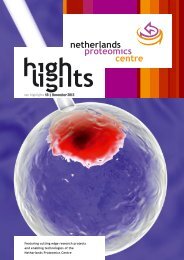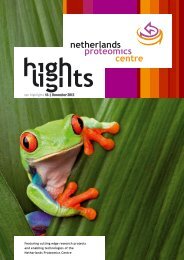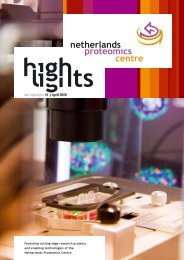~ 40,000small moleculesOOHHOOHBFigure 2 | Search for potent ATX inhibitors.About 40,000 small molecules have been screened.Among the validated molecules the thiazolidine-2,4-diones were well represented. The mostscreenOOSNOOoptimisation(100x increased inhibition)ONSOOpotent thiazolidine-2,4-dione, inhibitor A wasselected for further optimisation. Replacing thecarboxylic acid in inhibitor A with a boronic acidyielded a highly potent ATX inhibitor (HA130).Finhibitor AIC = 2500 nMFHA130IC = 28 nMincreased potency (IC 50 = 28 nM) compared to inhibitor A(IC 50 =2.5 μM).To investigate how ATX inhibition affects circulating plasmaLPA levels in vivo, we tested HA130 in mice. We used HPLCtandem mass spectrometry to monitor the plasma levels of LPAand HA130. Injection of HA130 into mice resulted in a rapidfall in circulating LPA levels (see Figure 3)[1]. HA130 togetherwith PF-8380, an inhibitor recently reported by Pfizer, are theonly two inhibitors to date that have been demonstrated tolower LPA levels in vivo. After validation of HA130 in mice,the position of the boronic acid in HA130 was optimised frommeta to para resulting in inhibitor HA155 with a further 5-foldincrease in potency (IC 50 = 5.7 nM).10 | <strong>NPC</strong> Highlights 15 | Harald AlbersCrystal structure In 2011 the crystal structure of ATX wasresolved independently by two groups (the Perrakis group atNKI [3] and the Nureki group at the University of Tokyo[4]).These structures confirmed that a threonine residue and twozinc ions are necessary for activity of ATX. Furthermore, thesestructures showed that ATX specifically binds its lipid substratesin a hydrophobic pocket extending from the active siteof ATX. This pocket accommodates the alkyl chain of the lipidsLPA plasma levels (µM)Vehicle HA1301.51.00.50.00 5 10 15 20Time (min)Figure 3 | In vivo validation. Injection of HA130 in mice resulted in a rapidfall of plasma lysophosphatidic acid (LPA) levels.as observed in various crystal structures of ATX. The crystalstructure of ATX in complex with HA155 obtained by thePerrakis group (see Figure 4A) confirmed our hypothesis thatHA155 targets the threonine oxygen nucleophile in the ATX activesite via the boronic acid moiety (see Figure 4B).In addition, one of the boronic acid hydroxyl moieties is tetheredby the two zinc ions in the ATX active site. Thus the boronicacid targets not only the threonine oxygen nucleophile,but also the two zinc ions that are essential for catalytic activityof ATX. Another interesting feature is the binding of thehydrophobic 4-fluorobenzyl moiety of HA155 to the hydrophobicpocket in ATX, to which the alkyl chain of the lipid usuallybinds (see Figure 4C).Now with the HA155-ATX structure in hand we were able torationally design novel boronic-based inhibitors. The mostpotent inhibitor resulting from these modifications turned outto be compound E-28 (see Figure 4D).Molecular docking In order to explain the binding of inhibitorE-28 to ATX, we decided to calculate likely binding poses [5].For this purpose, we used the Glide (grid-based ligand dockingwith energetics) docking software. With this software it is possibleto dock molecules into the active site of a protein and toevaluate the calculated binding poses of these molecules usinga scoring function. The best docking pose for E-28 suggeststhat the 4-fluorobenzyl moiety binds to a different area in thehydrophobic pocket compared to the binding of this moietyin HA155 with ATX (compare Figure 4C with 4D). This findingmay be used to design new inhibitors that fully exploit thehydrophobic pocket in ATX, opening further options for inhibitordesign[6].Promising prospects In conclusion, we discovered thiazolidine-2,4-dionesas potent non-lipid ATX inhibitors. Replacingthe carboxylic acid in the most potent thiazolidine-2,4-dionescreening hit with a boronic acid increased the inhibitorypotency tremendously. The resulting compound HA130 dramaticallylowered LPA levels in mice demonstrating that ATXis a valid target for manipulating LPA levels in vivo. Exploringstructure-activity relations building on HA155, a positionalboronic acid isomer of HA130 with higher affinity for ATX,resulted in a number of potent inhibitors. Using the crystalstructure of ATX liganded with optimised inhibitor, HA155, wewere able to rationally design novel inhibitors with high affinityfor ATX.
ABHA155Figure 4 | ATX structure and inhibitor binding.(A) Surface representation of ATX with inhibitorHA155 (magenta). (B) Binding of HA155 to thethreonine oxygen nucleophile and two zinc ions.(C) Two-dimensional representation displaying howThreonineHA155 binds to the ATX active site. (D) Schematicrepresentation of how inhibitor E-28 binds differentlyto ATX compared to HA155 based on theZinc(II)results of molecular docking experiments.CDFOHA155 ATXZincE-28N SOHOOB OFOHThreonineONNOOOHB OOHHydrophobic pocketActive siteFinally, molecular docking efforts proved useful to explainunexpected high potency of E-28 and suggested that thehydrophobic pocket near the ATX active site may be exploitedmore in future for the design of new inhibitors. Further developmentof boronic acid-based inhibitors of ATX holds promisefor therapeutic use in ATX/LPA-dependent pathologies.Harald Albers completed his PhDstudy at the <strong>Netherlands</strong> CancerInstitute in Huib Ovaa’s group(Division Cell Biology II).Thesis: Development of ATX andDUSP inhibitors,Leiden, 4 April <strong>2012</strong>.References1 Albers, H.M.H.G. et al. (2010) Boronic acid-based inhibitorof autotaxin reveals rapid turnover of LPA in the circulation.PNAS 107, 7257-7262.2 Albers, H.M.H.G. et al. (2010) Discovery and optimizationof boronic acid-based inhibitors of autotaxin. J Med Chem53, 4958-4967.3 Hausmann, J. et al. (2011) Structural basis for substratediscrimination and integrin binding by autotaxin. NatStruct Mol Biol 18, 198-204.4 Nishimasu, H. et al. (2011) Crystal structure of autotaxinand insight into GPCR activation by lipid mediators. NatStruct Mol Biol 18(2), 205-12.5 Albers, H.M.H.G. et al. (2011) Structure-based design ofnovel boronic acid-based inhibitors of autotaxin. J MedChem 54, 4619-4626.6 Albers, H.M.H.G. and Ovaa, H. (<strong>2012</strong>) Chemical evolutionof autotaxin inhibitors, Chem Rev Epub ahead of printsummaryResearch teamNKI-AVL Amsterdam: Harald Albers and Huib Ovaa (Division ofCell Biology II), Wouter Moolenaar (Division of Cell Biology I),Anastassis Perrakis (Division of Biochemistry).ContactDr. Harald AlbersThe <strong>Netherlands</strong> Cancer Institute (NKI-AVL)Division of Cell Biology IIPlesmanlaan 1211066 CX AmsterdamT +31 20 512 1979h.albers@nki.nl| 11Autotaxin (ATX) is a secreted phosphodiesterase that hydrolysesthe lipid lysophosphatidylcholine (LPC) to producelysophosphatidic acid (LPA). The ATX-LPA signalling axis hasbeen implicated in inflammation, fibrosis, and tumour progression,rendering ATX an attractive drug target. By screening achemical library, we have identified thiazolidine-2,4-dionesas inhibitors of ATX that selectively inhibit ATX-mediated LPAproduction both in vitro and in vivo. Inhibitor potency wasincreased approximately 100 fold after the incorporation ofa boronic acid moiety (inhibitor HA130), designed to targetthe threonine oxygen nucleophile in the ATX active site. Wedesigned new inhibitors based on the crystal structure of ATXin complex with HA155, a positional boronic acid isomer ofHA130, which resulted in a highly active analogue of HA155.To understand the binding of this novel inhibitor with nanomolarpotency, we performed molecular docking experiments.Intriguingly, molecular docking suggested a remarkable bindingpose for this inhibitor, which differs from the original bindingpose of HA155 for ATX, opening further options for new inhibitordesigns. The use of crystal structures of ATX-inhibitor complexeswill aid medicinal chemistry efforts to further develop the ATXinhibitors into therapeutic agents.






